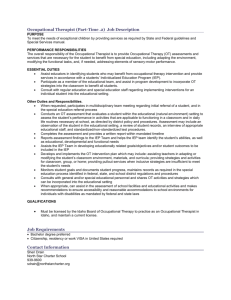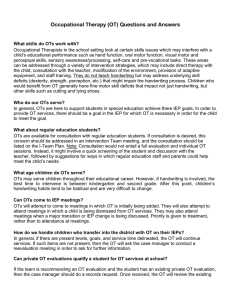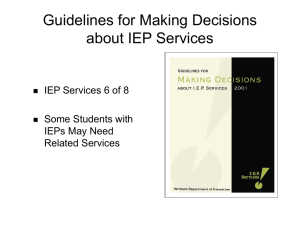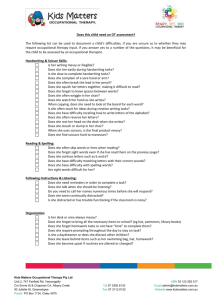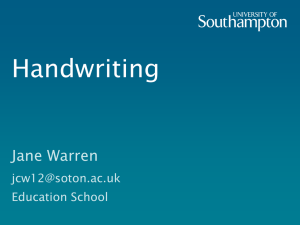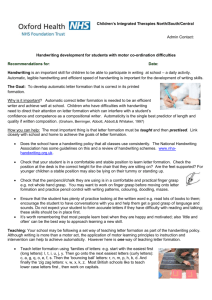educationally_related_ot__chelt_parents1
advertisement
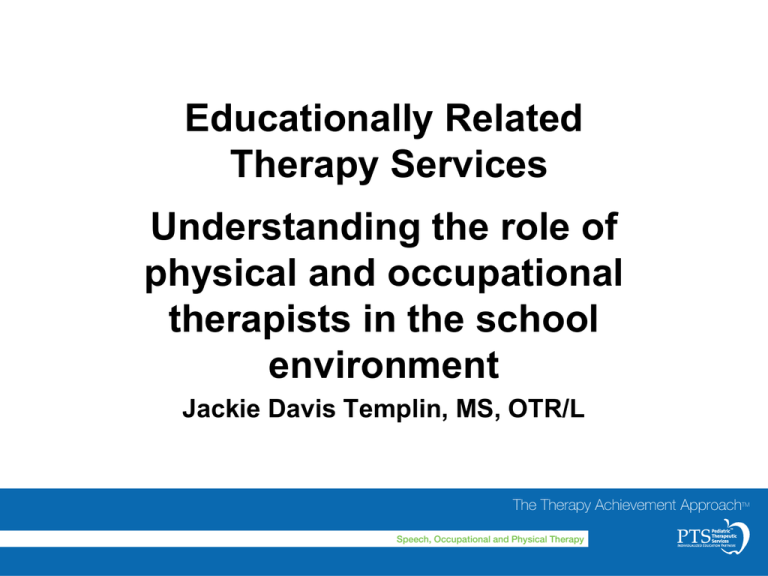
Educationally Related Therapy Services Understanding the role of physical and occupational therapists in the school environment Jackie Davis Templin, MS, OTR/L What are the venues for educational services? • 0-3 year old Early intervention, administered thru County Mental Health, family and child focused, home or preschools • 3-preK, thru Intermediate Units and School Districts, focus on preparing child for educational setting • K-12, school based, focus on access to education. WHY REFER A CHILD TO RELATED SERVICES? • The Child must have a problem with an observable, functional skill that is critical to his ability to function in the school environment, and to succeed in the classroom. • The child’s functional problem must be due to clinical findings that are responsive to therapeutic techniques or intervention. Avenues for provision of OT and PT services in Schools • IDEA (IEPs) – student must also need special education or speech services (speech can be a primary service) • Rehab Act of 73 (Service Agreements) – student must have “a mental or physical impairment that limits one or more major life activities” • OT and PT are not stand alone providers and cannot serve students who do not qualify for special education (IEP) or disability related acommodations(504) What is an IEP? • What does it look like? • Lawfully binding document with school district, student and parents • OT’s contribute to Present Educational levels, Goals (may or may not be therapy specific), Specially Designed Instruction, Levels of Service (for related services). What is a 504 service agreement • Agreement between school district and parents to provide accommodation to a student with a disability that limits a major life function • May include provision of therapy services • May include modifications to school environment How are students referred to OT in Schools • Screens (brief look at student functional problems in context of school environment, usually does not involve testing). May lead to therapists recommendation for full eval • OT Evaluations are lengthier, most costly to School districts, may involve testing and more complete assessment of function in school setting, recommendations. Must have signed PTE. • Re-evals periodically assess child school function in areas of concern by teachers, related service provider. Must have signed PTR. Therapy Services on a Continuum • Move from direct to consultative role • Decrease frequency as need decreases • Work toward carryover of skills in absence of therapist • Success when therapy is no longer needed. Occupational Therapy Child Exhibits Problems that Impact Ability to: • • • • • Write and Draw Manipulative Tools such as Scissors Attend to Tasks and Organize Work due to Sensory Processing Problems Perform Self-care Skills Occupational Therapy in the schools does not: • Cure disabling conditions • Teach routine keyboarding and handwriting curriculums • Maintain range of motion • Fabricate splints and orthotics Educationally based therapy vs. medically based therapy • • • • Therapy is delivered to students following very specific federal laws. Therapy is a related service in schools, not a academic discipline Therapy supports the child in his/her ability to access their education Physician prescription does not qualify a student for school based services • Recommendation of outpatient PT and OT does not qualify a student for school based therapy • Medical information from family is an important consideration for the team in making decisions about IEP’s The Least Restrictive Environment • • • • Integrate Communicate Accommodate Educational Relevance Where is the therapy room? Where is the equipment? School based therapy is done in the natural environment How is integrated therapy delivered? In the classroom, lunchroom, hallways, PE class, art class, field trips, etc., wherever it is relevant to the student goals during: • • • • • Classroom “centers” with students rotating between tasks During a writing, cutting, assembly, or cooking activities. On the playground during recess to facilitate recess skills In Physical education, art or music class Moving between special classes in the hallway and on stairs • Arrival at school to follow classroom routine with • clothing, backpack, homework, etc. How and where OT’s work in the school building? • Pull individual student out of the classroom to another area- most restrictive, least preferred • Push in classroom to work with individual child in context of a specific academic period • Group sessions either in classroom or outside classroom • Consultation with team, teachers and parents during or outside of school hours • RTII- may vary, within general education context • Qualification: Asking the Right Questions ? • ? Can another professional working with the child address the problem • ? Has the child received the service previously and did they progress • ? Are the child’s therapy goals observable, functional, and measurable and directly related to the child’s educational goals. • ? If the child is not progressing, will the child deteriorate without intervention • ? What is the appropriate combination of direct and consultative services • ? Are the issues related to the child’s therapy a priority in relation to other issues • ? Does the child’s functional deficit reflect a significant delay relative to his or her peers. Will the child’s condition respond to therapeutic intervention Use of Therapy Test Scores • Functional skills and ability to access the educational curriculum drive the decision of need for therapy, test scores generally do not • Test scores help to identify underlying issues and some may help to document progress Considerations for Discharge from therapy • Student is able to access their educational environment, with or with out adaptations or modifications • Interventions for the student do not require therapeutic expertise • Student needs can be addressed by school staff • Provision of therapy is not expected to result in progress • Student has received therapy for several years, no progress noted • Student does not want therapy and/or is uncooperative • Impact of therapy is minimal compared to consequences of missing classroom academics (MS and HS years). Therapy Services on a Continuum • Move from direct to consultative role • Decrease frequency as need decreases • Work toward carryover of skills in absence of OT • Success when OT is no longer needed. Developmental handwriting readiness skills • A growing number of typical kindergarten and first grade students are exhibiting problems with underlying hand skills that impact readiness for handwriting • OT will be consulting with general education kindergarten and first grade teachers to set up developmental exercise programs to help these students start handwriting with stronger hand skills. Educational Impact Good Candidate for Related Services Documented need for Specialist Stimulability
